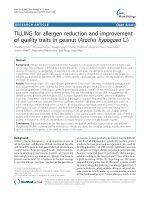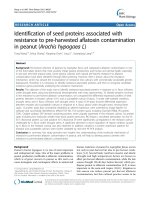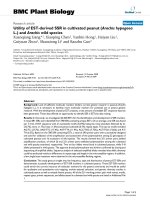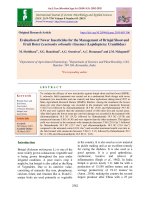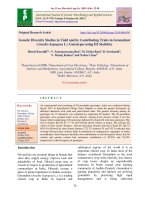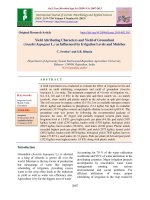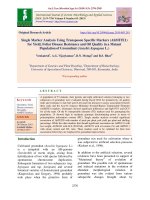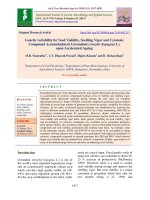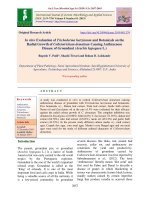Management of sucking pest of groundnut with newer molecules of insecticides (Arachis hypogaea L.)
Bạn đang xem bản rút gọn của tài liệu. Xem và tải ngay bản đầy đủ của tài liệu tại đây (176.17 KB, 4 trang )
Int.J.Curr.Microbiol.App.Sci (2018) 7(1): 566-569
International Journal of Current Microbiology and Applied Sciences
ISSN: 2319-7706 Volume 7 Number 01 (2018)
Journal homepage:
Original Research Article
/>
Management of Sucking Pest of Groundnut with Newer Molecules of
Insecticides (Arachis hypogaea L.)
V.K. Nigude, S.P. Patil, S.A. Patil and A.S. Bagade*
Department of Agril. Entomology, College of Agriculture Kolhapur - 416 004,
Maharashtra, India
*Corresponding author
ABSTRACT
Keywords
Groundnut, Jassids,
Thrips, Bio-efficacy
Article Info
Accepted:
06 December 2017
Available Online:
10 January 2018
Bio-efficacy of newer molecules of insecticides against sucking pests of groundnut
(Arachis hypogaea L.) was studied during July to October 2016, at Reasearch farm,
College of agriculture, Kolhapur. Groundnut crop was infested by Jassid (Empoasca kerri
Pruthi), Thrips (Scirtotharips dorsalis Hood). The experiment was laid out in randomized
block design with eight treatment and three replications with view to find out the effective
insecticides against sucking pest of groundnut at Agronomy field, college of agriculture
Kolhapur during Rabi 2016-17. Variety TAG-24 was sown on 1st July. The insecticide
used for the treatment were quinalphos 25 EC, acephate 75 SP, imidacloprid 17.8 SL,
lambda-cyhalothrin 5 EC, methomyl 40 SP, buprofenzin 25 SC, chlorpyriphos 20 EC. The
results of present investigation revealed that the treatment with imidacloprid 17.8 SL was
significantly most effective treatment for the control of sucking pest.
Introduction
Groundnut (Arachis hypogaea L.) is an annual
legume crop, also known as peanut, earthnut,
monkey– nut and goobers. It forms the
world’s largest source of edible oil and ranks
13th among the food crops and is also 4th most
important oilseed crop of the world. It is
grown in tropical and subtropical countries.
Cultivated groundnut has been reported from
South America (Weiss, 2000). It is grown in
26.4 million hectares with a production of
38.20 million tones and productivity of 691 kg
ha–1(FAO, 2010). Asia posses 1st rank in area
(63.4%) and production (71.1%). Major
groundnut countries are India (26%), China
(19%) and Nigeria (11%). In India is mainly
grown in the southern and north–western
states; Gujrat, Andhra Pradesh, Tamil nadu,
Karnataka, Maharastra, and Madhya Pradesh,
together occupying about 90 percent of the
groundnut area in the country. The major
insect pest of groundnut are groundnut aphid
(Aphis craccivora Koch), leaf miner
(Stomopteryx nertara meyrick), stem borer
(Sphenoptera perotett camron), white grub
(Holotrichia consainguinia Blanchard), Bihar
hairy caterpillar (Spilosoma oblique walker),
Tobbaco caterpillar (Spodoptera litura Fab.),
Red hairy caterpillar (Amsacta albistriga
Butler), Jassid (Empoasca kerri Pruthi),
Thrips (Scritothrips dorsalis), Termite
566
Int.J.Curr.Microbiol.App.Sci (2018) 7(1): 566-569
(Odontotermes obesus Rambur) as reported
Atwal and Dhaliwal (2008). However, aphid
was not considerd to be a serious pest of
groundnut until late 1980 (Nandgopal, 1992).
Mostly, groundnut insect pests are sporadic in
occurrence and distribution. However, there
are instances of total crop loss caused by a
single pest species. Although many insect
species live and feed on the groundnut crop,
only a few causes significant damage that
result in large reductions in pod and haulm
yields.
cm and 10 cm, respectively. Observations
were recorded after 3, 7 and 10 days of
spraying on sucking pest infesting groundnut.
Jassids, Empoasca kerri (Pruthi)
Numbers of jassids on three compound leaves
(upper, middle and lower) per plant were
recorded from selected plants from each of the
five plants as per the method suggested by
Yeotiker et al., (2015).
Thrips, [Scirtothrips dorsalis (Hood)]
Materials and Methods
The experiment was laid in simple randomized
block design with eight treatments and three
replications. Net plot size was 3.00 x 1.80 m2.
Row to row and plant to plant spacing was 30
Numbers of jassids on three compound leaves
(upper, middle and lower) per plant were
recorded from selected plants from each of the
five plants as per the method suggested by
Yeotiker et al., (2015)
Table.1 Bio-efficacy of newer molecules of insecticides against jassids on groundnut
Tr.No
3
DAS
2.14
(1.63)
Mean survival population of Jassids/ 3leaves
First Spraying
Second Spraying
7
10 DAS
Mean
3
7
10 DAS
DAS
DAS
DAS
2.94
3.19
2.75
2.28
2.80
2.97
(1.86)
(1.92)
(1.80)
(1.67) (1.82)
(1.86)
Mean
1.20
(1.30)
0.56
(1.03)
1.63
(1.46)
1.08
(1.26)
2.49
(1.73)
1.86
(1.54)
1.77
(1.49)
1.16
(1.27)
1.26
(1.32)
0.73
(1.11)
1.79
(1.51)
1.21
(1.31)
2.37
(1.69)
1.93
(1.56)
1.80
(1.50)
1.29
(1.32)
Treatments
T1
Quinalphos 25 EC
T2
Acephate 75 SP
T3
Imidacloprid 17.8 SL
T4
Lambda-cyhalothrin
5 EC
0.89
(1.18)
1.47
(1.40)
2.38
(1.70)
1.58
(1.42)
1.03
(1.23)
1.63
(1.46)
2.34
(1.68)
1.66
(1.45)
T5
Methomyl 40 SP
1.28
(1.33)
1.78
(1.51)
2.64
(1.77)
1.90
(1.53)
1.39
(1.37)
1.84
(1.53)
2.42
(1.71)
1.88
(1.53)
T6
Buprofenzin 25 SC
2.12
(1.62)
2.88
(1.84)
3.11
(1.90)
2.70
(1.78)
2.23
(1.65)
2.73
(1.80)
2.89
(1.84)
2.61
(1.76)
T7
Chlorpyriphos 20 EC
2.89
(1.84)
3.00
(1.87)
3.27
(1.94)
3.05
(1.88)
2.98
(1.87)
3.06
(1.89)
3.22
(1.93)
3.00
(1.89)
T8
Untreated control
8.88
(3.06)
9.08
(3.10)
8.92
(3.07)
8.96
(3.07)
8.97
(3.08)
9.16
(3.11)
8.99
(3.08)
9.04
(3.09)
0.06
0.13
0.02
0.07
0.03
0.11
0.04
0.11
0.05
0.13
0.03
0.09
SE +
CD at 5 %
DAS = Days after spray
*Figures in parentheses are transformed values
567
2.68
(1.78)
Int.J.Curr.Microbiol.App.Sci (2018) 7(1): 566-569
Table.2 Bio-efficacy of newer molecules of insecticides against thrips on groundnut
Tr.No
Treatments
T1
Quinalphos 25 EC
T2
Acephate 75 SP
T3
Imidacloprid 17.8 SL
T4
T5
Lambda-cyhalothrin
5 EC
Methomyl 40 SP
T6
Buprofenzin 25 SC
T7
Chlorpyriphos 20 EC
T8
Untreated control
3
DAS
1.49
(1.71)
1.15
(1.28)
0.79
(1.14)
1.06
(1.24)
1.18
(1.30)
1.46
(1.62)
1.55
(1.90)
8.60
(3.02)
0.02
0.07
SE +
CD at 5 %
DAS = Days after spray
*Figures in parentheses are transformed values
Mean survival population of thrips/ 3leaves
First Spraying
Second Spraying
7
10 DAS
Mean
3
7
10 DAS
DAS
DAS
DAS
1.85
2.03
1.79
1.59
1.96
2.14
(1.54)
(1.59)
(1.61)
(1.45) (1.57)
(1.63)
1.29
1.53
1.32
1.22
1.49
1.68
(1.34)
(1.43)
(1.35)
(1.31) (1.41)
(1.47)
0.95
1.17
0.97
0.90
1.20
1.30
(1.20)
(1.29)
(1.21)
(1.18) (1.30)
(1.34)
1.23
1.44
1.24
1.16
1.45
1.62
(1.32)
(1.39)
(1.31)
(1.29) (1.40)
(1.46)
1.36
1.58
1.37
1.27
1.56
1.73
(1.36)
(1.44)
(1.36)
(1.33) (1.44)
(1.49)
1.79
1.98
1.74
1.52
1.88
2.08
(1.51)
(1.57)
(1.56)
(1.42) (1.54)
(1.61)
2.02
2.16
1.91
1.64
2.04
2.20
(1.59)
(1.63)
(1.71)
(1.46) (1.60)
(1.64)
9.08
8.98
8.88
7.15
6.38
7.05
(3.10)
(3.08)
(3.06)
(2.77) (2.62)
(2.75)
0.03
0.02
0.03
0.02
0.04
0.09
0.08
0.10
0.08
0.11
Mean
1.89
(1.55)
1.46
(1.39)
1.13
(1.27)
1.41
(1.38)
1.52
(1.42)
1.82
(1.52)
1.96
(1.56)
6.86
(2.71)
the most effective treatment compared to
other insecticidal treatments in reducing the
survival population of jassids. The treatment
with lambda-cyhalothrin 5 EC @ 0.50 ml/lit.
(1.66 jassids/3 leaves) was the next best
effective treatment, followed by acephate 75
SP @ 1.0 gm/lit (1.80 jassids/3 leaves) (Table
1).
Results and Discussion
First spray for jassids
Overall results on efficacy of treatments
indicated that imidacloprid 17.8 SL @ 0.75
ml/lit. (1.16 jassids/3 leaves) was consistently
most effective as compared to other
treatments in reducing the survival population
of jassids.
First spray for thrips
The treatment with lambda-cyhalothrin 5 EC
@ 0.50 ml/lit (1.58 jassids/3 leaves) was the
next best effective treatment, followed by
acephate 75 SP @ 1.0 gm/lit (1.77 jassids/3
leaves).
Overall results on efficacy indicated that
imidacloprid 17.8 SL @ 0.75 ml/lit (0.97
thrips/3 leaves) was the consistently most
effective compared to other treatments in
reducing the survival population of thrips.
The treatment with lambda-cyhalothrin 5 EC
@ 0.50 ml/lit (1.24 thrips/3 leaves) was the
next best effective treatment, closely followed
by acephate 75 SP @ 1.0 gm/lit (1.32 thrips/3
leaves) (Table 2).
Second spray for jassids
Overall results on efficacy of treatments
indicated that imidacloprid 17.8 SL @ 0.75
ml/lit (1.29 jassids/3 leaves) was found to be
568
Int.J.Curr.Microbiol.App.Sci (2018) 7(1): 566-569
their management. Publ. Rajender
nagar, Ludhiana, pp. 274–277
FAO 2010. FAO Production Year book, Vol.
60.
Nandgopal, V. 1992. Studied on integrated
pest management in groundnut in
Saurastra Ph.D. thesis submitted to
Saurasta University, Rajkot, Pesticides,
8: 246.
Weiss, E. A. 2000. Oilseed Crops. Publ. by
Blackwell Science, London. p. 13.
Yeotikar, S. G., More, D. G. and Gaikwad, B.
B. 2015. Seasonal incidence of major
insect pests of soybean. Indian J. agric.
Sci., 39(4): 341-346.
Second spray for thrips
Overall results on efficacy indicated that
imidacloprid 17.8 SL @ 0.75 ml/lit (1.13
thrips/3 leaves) was the most effective as
compared to other treatments in reducing the
survival population of thrips. The treatment
with lambda-cyhalothrin 5 EC @ 0.50 ml/lit
(1.41 thrips/3 leaves) was the next best
effective treatment, closely followed by
acephate 75 SP @ 1.0 gm/lit (1.46 thrips/3
leaves).
References
Atwal, A.S. and Dhaliwal, G. S. 2008.
Agricultural pests of south Asia and
How to cite this article:
Nigude, V.K., S.P. Patil, S.A. Patil and Bagade, A.S. 2018. Management of Sucking Pest of
Groundnut with Newer Molecules of Insecticides (Arachis hypogaea L.).
Int.J.Curr.Microbiol.App.Sci. 7(01): 566-569. doi: />
569
